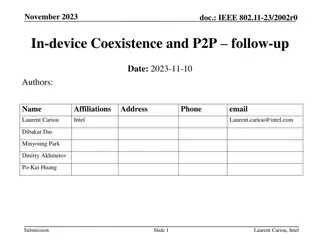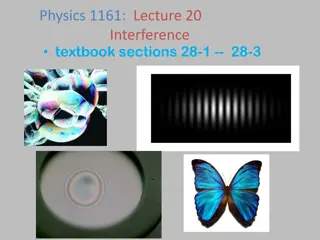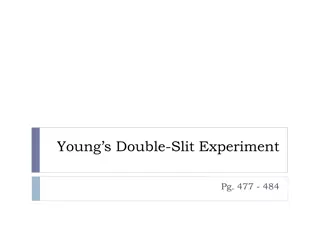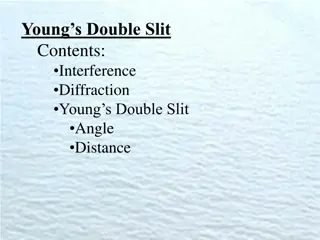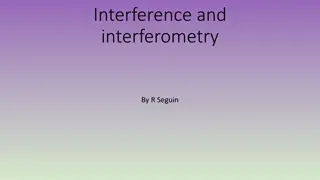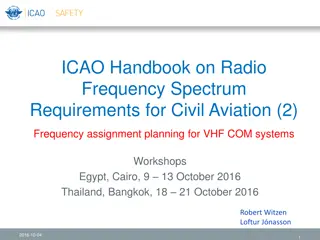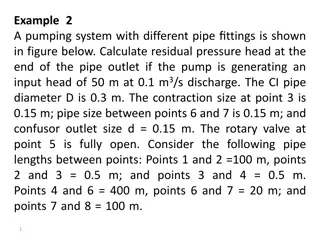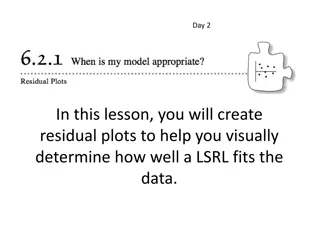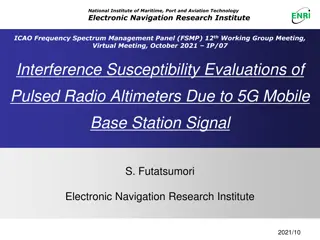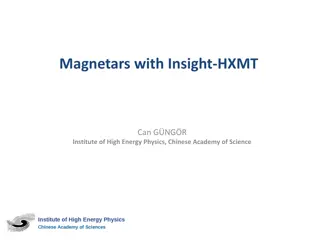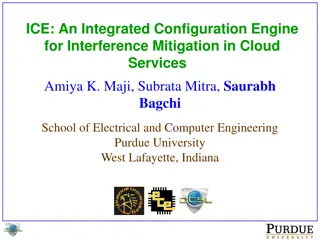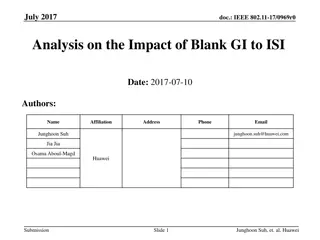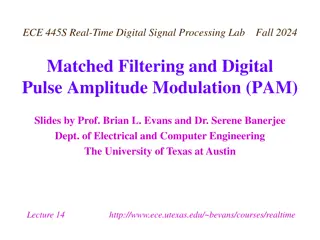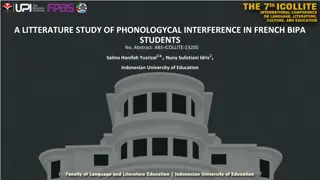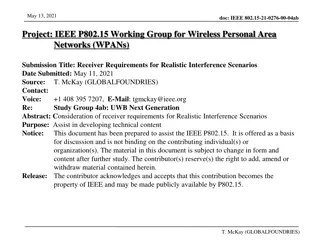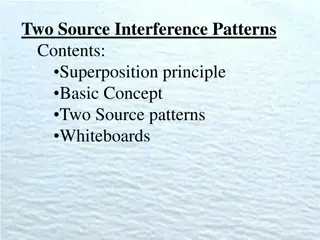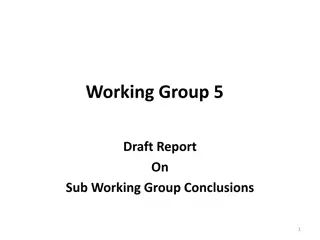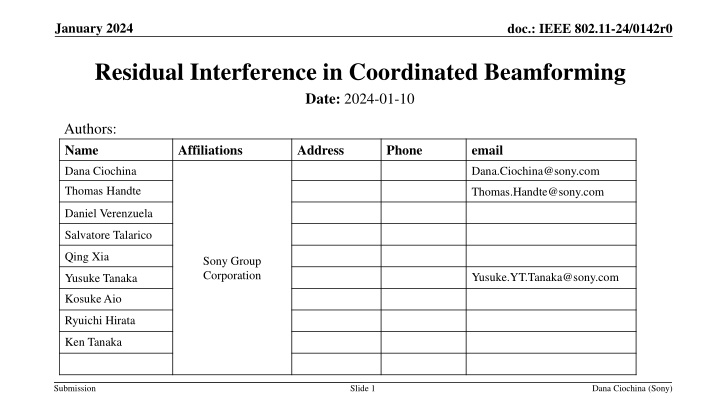
Residual Interference in Coordinated Beamforming for Wireless Networks
Explore the impact of residual interference in coordinated beamforming for IEEE 802.11 networks, evaluating enhancements like beamforming extension and channel estimation. Discover how non-aligned transmissions reduce overhead and simplify implementation, leading to improved throughput and reduced queuing delay.
Uploaded on | 2 Views
Download Presentation

Please find below an Image/Link to download the presentation.
The content on the website is provided AS IS for your information and personal use only. It may not be sold, licensed, or shared on other websites without obtaining consent from the author. If you encounter any issues during the download, it is possible that the publisher has removed the file from their server.
You are allowed to download the files provided on this website for personal or commercial use, subject to the condition that they are used lawfully. All files are the property of their respective owners.
The content on the website is provided AS IS for your information and personal use only. It may not be sold, licensed, or shared on other websites without obtaining consent from the author.
E N D
Presentation Transcript
January 2024 doc.: IEEE 802.11-24/0142r0 Residual Interference in Coordinated Beamforming Date: 2024-01-10 Authors: Name Affiliations Address Phone email Dana Ciochina Dana.Ciochina@sony.com Thomas Handte Thomas.Handte@sony.com Daniel Verenzuela Salvatore Talarico Qing Xia Sony Group Corporation Yusuke.YT.Tanaka@sony.com Yusuke Tanaka Kosuke Aio Ryuichi Hirata Ken Tanaka Submission Slide 1 Dana Ciochina (Sony)
January 2024 doc.: IEEE 802.11-24/0142r0 Introduction CBF enables multiple STAs to transmit simultaneously Important technology to improve latency, as the scenarios under which CBF is bringing improvements are particularly scenarios in which interference levels would not allow a concurrent transmission otherwise Several contributions have shown the gains of this technology Improvement in throughput [1]-[6] Reduction of queuing delay [2] Residual interference in CBF is due to Interference on the legacy preamble Interference on the GI, which may require synchronization In this contribution, we evaluate the severeness of the residual interference for one precoder choice in both aligned and non-aligned CBF transmissions Non-aligned transmission are of interest because of less overhead and easier implementation We show the improvements of extending the beamforming over the preamble We further show benefits of enhancing the channel and noise estimation, particularly in the case of aligned transmission Submission Slide 2 Dana Ciochina (Sony)
January 2024 doc.: IEEE 802.11-24/0142r0 Simulation Scenario AP Configuration 4Tx antennas 21dBm Tx power NF: 7 ~ -90dBm 20MHz channels BD Beamformer No additional power adjustment 1 SS .11ax SU PPDU format, 4xLTFs, 0.8usGI Fixed MCS X: 7dB STA Configuration 2 Rx antennas MMSE receiver Channels: NLOS Model D NDP + Channel Estimation, Aging based on Model D with environmental speed Within ED range Submission Slide 3 Dana Ciochina (Sony)
January 2024 doc.: IEEE 802.11-24/0142r0 Overlapping Preambles Scenarios in which the 2 APs have an offset in the transmission start can be interesting for various reasons: Overhead reduction allow Sharing AP to take decision on configuration, Shared AP checks configuration in SIG fields and aligns NAV Status at Shared AP not allowing an aligned start Legacy and SIG fields are currently not beamformed in most cases Overlap of non-beamformed preambles leads to errors in the preamble decoding on top of payload decoding Comparison of transmission with and without beamforming applied on the preambles PPDUoAP1 oSTA1 PPDUAP1 >STA1 Submission Slide 4 Dana Ciochina (Sony)
January 2024 doc.: IEEE 802.11-24/0142r0 Error Rates in Preamble Decoding for Offset Transmissions Transmission Offset of the Shared AP is within the Preamble interval (HER) in case of non- beamformed preamble transmission can reach 40% Extending the Beamforming on the preambles reliably solves the problem, keeping the error rate below 10 2 Submission Slide 5 Dana Ciochina (Sony)
January 2024 doc.: IEEE 802.11-24/0142r0 Error Rates in Payload Decoding for Offset Transmissions Payload errors occur due to: Residual interference in the estimation fields leads to erroneous channel and noise estimation in the case of overlapped transmissions without beamformed preambles Very good performance around synchronization, but large errors afterwards With extended beamforming, MCS can be reliably increased Submission Slide 6 Dana Ciochina (Sony)
January 2024 doc.: IEEE 802.11-24/0142r0 Residual Interference Aligned Start In the case of synchronized transmissions or transmissions with small offsets, even when beamforming is applied, some residual interference in the LTFs remains. This leads to errors in the MMSE equalizer and also to higher sensitivity to other channel impairments, in particular channel aging A potential solution is extending the LTF fields to allow for interference estimation and improvement of noise estimation e.g., AP transmissions using different sets of orthogonal LTFs Submission Slide 7 Dana Ciochina (Sony)
January 2024 doc.: IEEE 802.11-24/0142r0 Summary In coordinated beamforming, interference levels in the legacy preambles can lead to large error rates in both header as well as payload, when a time offset between the transmissions of the 2 APs exist Extending the beamforming over the preamble fields can solve the problem and give robust results even under increased channel aging values Depending on scenarios, residual interference may remain in the LTFs leading to errors in the MMSE receiver Extended LTFs to separate the effect of two APs in the channel and noise estimation process improve the MMSE performance especially for synchronized transmissions Submission Slide 8 Dana Ciochina (Sony)
January 2024 doc.: IEEE 802.11-24/0142r0 References [1] 11-19/1594r2 Coordinated Beamforming/Null Steering Protocol in 802.11be [2] 11-22/1821 System Level Simulation of Co-BF and Joint TX [3] 11-23/1193r1 Nulling Performance of Coordinated Beamforming [4] 11-23/0776r2 Performance of C-BF and C-SR [5] 11-24/0011r0 Coordinated Spatial Nulling Simulations [6] 11-24/0012r0 Coordinated Spatial Nulling Concept [7] 11-19/0638r0 Nulling and Coordinated Beamforming Submission Slide 9 Dana Ciochina (Sony)

